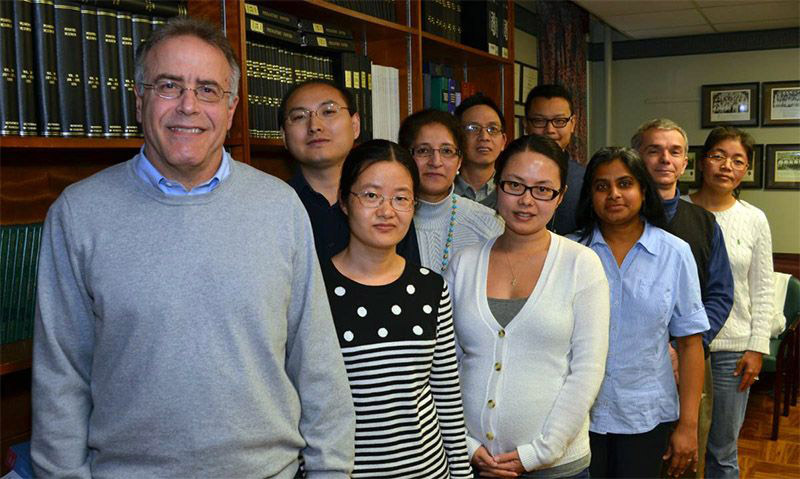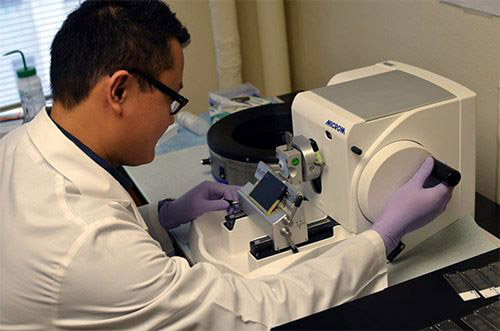
My laboratory, which was established in 1990, and has been funded from the National Institutes of Health for the past 20 years, is focused on elucidating the cellular and molecular regulation of kidney development. Kidney development is a complex process that requires precise integration of various progenitor cell populations of diverse embryonic origins. In about 1 of 500 births, some abnormality occurs in kidney development, leading to congenital anomalies of the kidney and urinary tract (CAKUT) in children. CAKUT plays a causative role in 30-50% of cases of end stage kidney disease (ESKD) in children, and predisposes to the development of hypertension and other renal cardiovascular diseases in patients that survive to adolescence and adulthood.. Therefore, the long-term goal of our research is to uncover the developmental mechanisms accounting for CAKUT, and help in designing novel theapeutic strategies. Read More
Ongoing projects in the lab are:
- Epigenetic control of renal development. We are interested in the molecular mechanisms which balance nephron progenitor self-renewal and differentiation. Ultimately, these mechanisms will determine the final nephron number and thus susceptibility to hypertension and chronic kidney disease. We are currently focused on chromatin-based repressive mechanisms, e.g., Histone deacetylation, H3K9/K27/K79 methylation. Our work tests the hypothesis that chromatin bivalency (active/repressive chromatin) is crucial for cell fate decisions (I.e., renewal vs. differentiation). Our toolbox utilizes mouse genetics, epigenetics (Chromatin-based techniques, such ChIP-Seq and ATAC-Seq), organotypic metanephric cultures, and various cell- and tissue based biochemical and genetic approaches.
- Gene-environment interactions in renal development. A mouse model of human renal dysplasia was developed in our lab. Induction of abnormal nephron differentiation requires the cooperation of a genetic defect (bradykinin B2 receptor gene disruption in the ureteric bud lineage) and an embryonic stressor (gestational high salt intake). Differential gene expression analysis in these mice has revealed a novel multifactorial paradigm of aberrant renal epithelial cell differentiation involving epigenetic factors, tumor suppressors, transcription factors, cell cycle proteins, and cell-cell adhesion molecules.
Samir El-Dahr, MD
Jane B. Aron Professor
Chairman, Department of Pediatrics
Phone:504-988-6692

Chao-Hui Chen, PhD - Laboratory technician
Sylvia Hilliard, PhD - Post doc fellow
Hongbing Liu, PhD - Research Assistant Professor
1. El-Dahr SS, Li Y, Liu J, Gutierrez E, Herring-Smith KS, Signoretti S, Pignon J-C, Sinha S, Saifudeen Z. P63+ ureteric bud tip cells are progenitors of intercalated cells. JCI Insight. 2(9). Pii: 89996. [Epub ahead of print] 2017
2. Lara LS, Bourgeois CR, El-Dahr SS, Prieto MC. Bradykinin/B2 receptor activation regulates renin in M-1 cells via protein kinase C and nitric oxide. Physiol. Rep. 5(7): e13211. 2017
3. Hilliard SA, and El-Dahr SS. Epigenetics of renal development and disease. Yale J. Biol. Med. 89 (4): 565-573, 2016 Review. PMID: 28018145
4. Hilliard S, and El-Dahr SS. Epigenetic mechanisms in renal development. Pediatr. Nephrol. 31: 1055-1060, 2016. PMID 26493068
5. Kopkan L, Huskova Z, Jichova S, Cervenkova L, Cervenka L, Saifudeen Z, El-Dahr SS. Conditional Knockout of collecting duct bradykinin B2 receptors exacerbates angiotensin II-induced hypertension during high salt intake. Clin. Exp. Hypertens. 38: 1-9, 2016. PMID: 26151827
6. Chen S, Yao X, Li Y, Saifudeen Z, Bachvarov D, El-Dahr SS. Histone deacetylase 1 and 2 regulate Wnt and p53 pathways in the ureteric bud epithelium. Development. 15;142(6):1180-92, 2015. PMID: 25758227
7. Adli M1, Parlak M, Li Y, El-Dahr S. (2015) Epigenetic States of Nephron Progenitors and Epithelial Differentiation. J Cell Biochem doi: 10.1002/jcb.25048.
8. Yan, L., Yao, X., Bachvarov, D., Saifudeen, Z., and El-Dahr, S. S. (2014) Genome-wide analysis of gestational gene-environment interactions in the developing kidney. Physiological genomics 46, 655-670.
9. Hilliard, S. A., Yao, X., and El-Dahr, S. S. (2014) Mdm2 is required for maintenance of the nephrogenic niche. Developmental biology 387, 1-14.
10. El-Dahr, S., Hilliard, S., Aboudehen, K., and Saifudeen, Z. (2014) The MDM2-p53 pathway: multiple roles in kidney development. Pediatr Nephrol 29, 621-627.
11. McLaughlin, N., Yao, X., Li, Y., Saifudeen, Z., and El-Dahr, S. S. (2013) Histone signature of metanephric mesenchyme cell lines. Epigenetics 8, 970-978.
12. Li, Y., Liu, J., McLaughlin, N., Bachvarov, D., Saifudeen, Z., and El-Dahr, S. S. (2013) Genome-wide analysis of the p53 gene regulatory network in the developing mouse kidney. Physiological genomics 45, 948-964.
13. El-Dahr, S. S., and Saifudeen, Z. (2013) Interactions between BdkrB2 and p53 genes in the developing kidney. Biological chemistry 394, 347-351.
14. Chen, S., and El-Dahr, S. S. (2013) Histone deacetylases in kidney development: implications for disease and therapy. Pediatr Nephrol 28, 689-698.
15. Saifudeen, Z., Liu, J., Dipp, S., Yao, X., Li, Y., McLaughlin, N., Aboudehen, K., and El-Dahr, S. S. (2012) A p53-Pax2 pathway in kidney development: implications for nephrogenesis. PloS one 7, e44869.
16. Aboudehen, K., Hilliard, S., Saifudeen, Z., and El-Dahr, S. S. (2012) Mechanisms of p53 activation and physiological relevance in the developing kidney. Am J Physiol Renal Physiol 302, F928-940.
17.Rosenberg, S. L., Chen, S., McLaughlin, N., and El-Dahr, S. S. (2011) Regulation of kidney development by histone deacetylases. Pediatr Nephrol 26, 1445-1452.
18. Hilliard, S., Aboudehen, K., Yao, X., and El-Dahr, S. S. (2011) Tight regulation of p53 activity by Mdm2 is required for ureteric bud growth and branching. Developmental biology 353, 354-366.
Pubmed listing of research publications:
https://www.ncbi.nlm.nih.gov/pubmed/?term=El-Dahr+S
